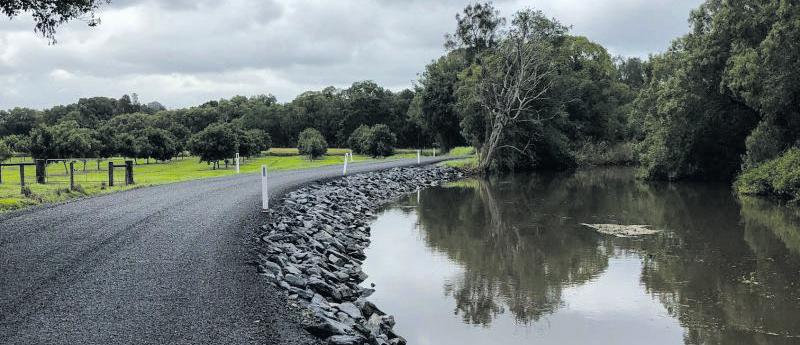
3 minute read
Sealing Richmond River Dirt Roads Leads to Cleaner Water and Better Fishing
By Robert Heyward
harm. Arguably, the greatest harm obnoxious people pose, is to themselves, by being so lacking in self-awareness and reflection; they have such a knack for being offensive, it defines and subsequently blinds them to all the things they could otherwise do to endear themselves to the rest of the world.
But ‘suffering’ obnoxious and annoying types is quite often a choice; not giving them the attention or airplay they so require is a highly effective interactional mitigation, and so is keeping in mind the wonderful adage by the French salon-frequenting La Bruyere, who once chimed, “To be unable to endure all the unpleasant characters of whom the world is full is not an admirable characteristic: we need, in our dealings, both gold coins and small change.”
Thus, what would any of us do without the ‘small change’ in our lives? Getting around with $100 notes in our pocket at all times is not practical, nor is it preferable, when you think of all the different purchases we ‘make’ on any given day. Akin to a lost, albeit some kind of mystical talent, Sherryl Jennifer once noted, “Tolerating annoying people is an art, that many may not know.” And least of all, those who are actually responsible for the infliction of any given annoyance. When it comes to annoyance, one line of thinking that can help offset all adverse reactions are the views of Robert Anton Wilson, who once said: “You are precisely as big as what you love, and precisely as small as what you allow to annoy you.”
The NSW Government, in collaboration with Ballina Shire Council, is making signifcant strides in protecting the Richmond River Estuary by sealing local dirt roads. This initiative, led by North Coast Local Land Services, aims to prevent thousands of tonnes of dirt and sediment from entering the estuary, thereby improving water quality and enhancing recreational and commercial fshing.
To date, 25 road sites spanning 15.5 kilometres across the local government area have been upgraded. These improvements have successfully prevented more than 2,200 tonnes of dirt road material, including rocks and mud, from washing into the Richmond River estuary during major food events.
Sealing dirt roads has proven to be one of the most effective methods for improving downstream habitats, ensuring cleaner water, and supporting healthier fsh populations. The project has focused on high-risk sites where dirt roads intersect or run adjacent to key waterways feeding into the estuary, areas particularly vulnerable to sediment being carried downstream during foods.
Across the broader region, over 50 kilometres of roads at 108 different sites, from Ballina to Bega, have been sealed to mitigate sediment runoff into waterways. In addition to road sealing, funding from the NSW Government’s Marine Estate Management Strategy is being used for riverbank stabilization, rehabilitation, and nutrient management, further supporting the health of the Richmond River.
The NSW Government has committed $165 million to the Marine
Estate Management Strategy, with a planned total investment of $286 million by June 2028. The Strategy outlines a comprehensive plan to protect and improve the state’s waterways, coastline, and estuaries over the next decade, addressing signifcant threats like sediment runoff, littering, and water pollution.
Minister for Agriculture
Tara Moriarty highlighted the impact of these efforts: “The work undertaken by LLS has effectively prevented the equivalent of half an Olympic-sized swimming pool of sediment from entering the Richmond River during each major river rise. We will continue to collaborate with Ballina Shire Council over the next two years to prioritize dirt road upgrades and improve water quality in the Richmond River estuary.”
Moriarty also emphasized the ecological importance of reducing sediment runoff: “Sediments lost from dirt roads settle in the estuary where sensitive marine vegetation like seagrasses grow. Seagrass is an incredibly important part of the marine estate as it flters nutrients and supports the nursery of important fsh species.”
Paul Crozier, Engineering Works Manager at Ballina Shire Council, praised the partnership’s success: “This collaboration between local government and natural resource management has delivered wholeof-community benefts. The works have not only improved the health of the river but also enhanced the safety of all road users in the area.”
For more information on the Marine Estate Management Strategy projects delivered by Local Land Services, visit NSW Local Land Services.











